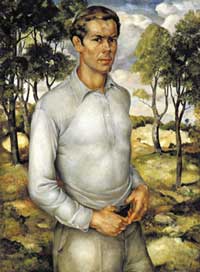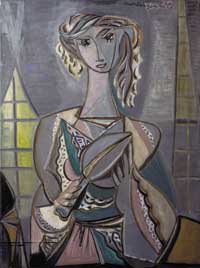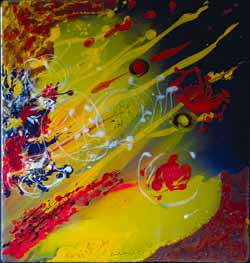Johannes Evert Hulsbergen
12 May 1901 - 20 March 1989
He received his first painting kit when he was 8 years old and started to draw and paint from books.
When he finished college at 18 he had to go and earn and put money aside to pay his way to the Amsterdam Academy. He worked for a photographer and retouched portrait photographs. He became quite expert in this field and had for a while his photostudio in Middelburg.
When he had saved enough money Han took private drawing lessons at the «Normaal School» in Amsterdam to prepare his examn for the State Academy of Amsterdam.
In 1926 the examn consisted mainly of precise drawing of statues and perspective. During this time he made a portrait of Professor de Vries.
After sitting the preliminary exams he was accepted and was allowed a government grant. He studied at the academy under Professor Wolter and Professor Roland Holst both hard line teachers, as well as Professor Bronned (sculpturing), who brought either their pupils to the highest levels or turned them into a drop out.
At 26 years old, his dreams and professional career were becoming a tangible reality.
While living on the Plantage Middenlaan he obtained some commissions for stage decoration for the Rika Hoppe Theater.
The serious and “solid” training of the Amsterdamse Academie, where the painting techniques, proper use of materials and preparation of canvasses were as important, if not more, as the talent and the style, in sofar it was clearly related to classical painting.
The indepth study of paints and colours enabled him to make his own paints throughout his professional life and understand the infinite behaviour of almost any material.
After two years he obtained together with Gerard Röling a loge at the Academy. That summer he travelled to Mallorca and the South of Spain and painted among others gypsy girls and children portraits for the family Fernandez in Granada. By his welmannered and pleasant behaviour he always was warmly received by families in foreign countries.
Han finished the Amsterdam Academy with flying colours, which resulted in a government grant to extend his studies at the Academia della Bell’ Arte in Florence (Italy) under Professor Casnesa.He worked in ufici and studied the Florentin masters.
The time in Italy at the womb of the great italian classics, gave an additional depth and dimension to his work and added an italian touch to his individual style.
An exhibition of his work at the acadamy of Florence incited the Corriera della Sera to write an article titled “Il Botticelli di 20° siecla veni da Ollanda” (The botticelli of the 20th Century comes from Holland).

Upon his return to Holland, the real challenge was yet to begin, find a studio with nor-thern light and start working for a living. All beginnings are tough, but gradually people found Hulsbergens' third floor double studio on the Singel canal 137 in Amsterdam to have their or their loved ones portraits painted for posterity.
Numerous short trips in the thirties took him to Paris, Madrid, Toledo and Granada to study the old masters and have a first hand visual experience of the localities.
His future wife Fieneke van der Sijp he met in 1935 in Amsterdam, where she studied piano at the conservatory and was engaged in the Amsterdam National Ballet. Han just had finished a large canvas «Alegorie der Muziek» as well as the portrait of Fieneke in the dunes.
They married in 1936 and moved to the Weteringschans across from the Rijks Museum. Among their friends were many artists, actors and writers and Han spend much time at the «Kring» (Circle for Artists)
For the important Amsterdam annual art exhibition (Arti et Amiciciae) Hulsbergen was to send in some of his work. He had been so busy making portraits of the “in crowd” that he had nothing to send. His clients though were happy to lend their paintings and to be part of the display at the exhibition.
That year of 1939, his portraits were elected by the jury, and Han Hulsbergen became the painter to receive by Her Majesty the Queen the Van Collem Prize. His work was recognised, he was to make a portrait of Her Royal Highness Queen Emma.
In 1939 the couple moved to Baricum a village of farmers, tucked away in the sandy briar fields of Holland, where the light was very special. It became the hide-out of artist; painters, sculptors, architects, authors and poets. (Today Televison people, performing artists, bankers and of course real estate agents).
The artists lived in harmonious cohabitation with the farmers, the latter worked the land the others painted it or put it into words. That was fine with the farmers. Gradually more artists discovered the virtues of this little “enclave”, once the proprietary stalking ground of Anton Mauve, now sheltered; Piet Mondriaan, Raoul Heijnckes, Han Hamdorff, Prof. Roland Holst, Geni Peter, Cees van Meegeren, Hooykaas, Paul Koning, Karel Appel, Tajiri, Paul de Lussanet... Other settlers installed themselves, ir. Van Gogh with the largest collection of his nephews works (which he donated to the Van Gogh museum in Amsterdam, on the condition that the city would build it), Mr. B. with the most amazing collection of Piet Mondriaan.
But it was not to remain so nice, World War II suddendly knocked on the door, invasion, occupation, hunger winter, house searches, Canadian shot-down pilots hiding in the attic, jew-ish friends to be sheltered.
Han had not been aware of the coming war and had gone to Twente for some portrait commissions. with great difficulty by bicycle and foot he returned to Blaricum.
Enough subjects to express on canvas, but no materials, they were as scarce as butter and flour.
Romantisism was past, world reality had burst into the peaceful country life. Visual expression descibed another dimension of mankind: the atrocities, the suffering, dictators. These had to be expressed, be put on canvas. Children were born, they needed to be fed, survival became number one, closeness with friends and neighbours grew. Only together we can survive while the underground resistance was trying to bite back at the opressor.Han’s art took a different expression, another dimension, the figures were less precise, the laborious fine painting and romantism, was replaced by a quicker dynamic brushstroke capturing the underlying power and showing what the people felt, where they were, how they suffered and how they tried to maintain against all odds their dignity. The five “war canvasses”, finished in 1948, some of them of important size, featuring crowds of people, were very powerful and depicted the era of country side living conditions in occupied Holland.
A triptique “House Search”, Hunger Winter” and “The Wisper” were hung at his first post war exhibtion in 1946 and sent the art critics howling. What happened to the Hulsbergen, the romantist, did he lose the touch? But none of these critics could neglect or miss the pure genius, the power and intensity of expression, neither the talent.
As a non conforming artist Hulsbergen went into the new post war era, reaping the acknowledgement of the international art buying world.
In 1952 he was send by the Government for a study trip to Greece, where he installed himself in an apartment in Piraeus, overlooking the bay with the backdrop of the mountains, on which the previous Greeks had so thoughtfully build the Parthenon for everyone to see.
Han was overwhelmed with the sheer beauty, the architecture, frescos and sculptures of the ancient Greeks, as welll as their current life, the people in the streets, the women washing, the things one could transport on a donkey, the fishing boats in the ports, the houses, the ruins, the Oracle of Delphi and... Hydra, where once discovered, he instantly moved his head-quarters.
f he was not talking to people or having a drink and a bite to eat, he was studying mythology or drawing. One sketch book after the other was filled with sketches and drawings of scenery, people, animals, mythological scenes and ruins.
There really was no time to make a canvas, time was precious, the impressions needed to be “fixed” now, before they’re gone.

Successfull exhibitions in Holland, New York, Dublin, London, Pittsburg followed in succession, while Han feverishly worked in his thatched roof studio on the Grenslaan in Blaricum. Always searching to get to the pure essence of painting. Reducing the number of lines, to achieve a more powerfull expression in portraits using five or six base lines, introducing angles in normally round faces.
At the The Hague national exhibition Hulsbergen was elected for the “Royal Begeer Prize”.
Suddenly his work was stamped “Cubist”. But it was not cubist as such. It was his own style, his own reduction of flowery worked out brush strokes to a more bold figurative tech-nique, full of expression and tension in the lines and composition.
Almost any major scene he had painted before in his precise detailed technique for which the artworld carried him on their hands, he reworked in this fast flowing spontaneous cubist like signature.
His talent, his indepth knowledge of tech-nique and a very steady hand enabled him to relate complex scenes back to a single continuous line. A composition as a signature.
With all its tensions and expression bundled in this one-time-only brush stroke.
This work breathes the talent as an artist, who has conquered the resilience of the brush, the resistance of oilpaint and the unyielding canvass.
When the art world, which had been holding their breath, finally accepted his “new style” and started to discover the quality and finesse of the stroke, Hulsbergen went yet off on to something totally different.
Through his continuous experimentation with materials, he found a concrete mixture which enabled him to sculpt as one would with clay. He called his invention “Meliora Beton”. As a sculptor he worked the metal armour and the concrete into sheer fragile looking sculptures and as a painter coloured and sealed the grey stone material as if it were a canvas.
As from 1955 his “Meliora” sculptures became a great success with architects and project developers, as a result a number of commissions came from government institutions as well as commercial corporations for murals and free standing sculptures.
His Meliora sculptures were exhibited in a number of galleries, parks and museums in Holland and England.
While sculpturing the rough concrete material Han still continued painting and moving forward with a style and composition of his own. More and more his paintings became abstract, not only using the traditional paints but other materials were often included, wood, sand, mother of pearl, resins, metals, glass, bottle caps, shells...
In 1967 through the aquaintance of the owner of a Dutch enamel factory, Han started painting with enamel. "Playing with fire", as he expressed it. Since enamel is nothing less than liquified glass at high temperature and cooled down in steps, Hulsbergen, with his particular talent of immediately grasping the particularities of materials, very quickly made oversized “paintings”, which to the expert opinion of specialists could not be done.
But it worked, the material held together and it did not crack even after the most rugged tests.

His enamels were an explosion of myriad colours, enhanced by the high intensity of the glass surface. After experimenting with different types of consistencies and techniques he was commissioned to do an enamel wall of eight meters high and fifty meters long, made of metal sheets of 4 by 1 meter.
A great new avenue opened for the factory, which meant for Hulsbergen to move on to new roads of experimentation.
Han took a walk about to Australia and stayed a year. Submerged by the beauty of the Australian outback and the vivid colours of the rocks, he could not sit idle and almost imme-diately started to work. His canvasses were made from available materials that australian nature provided. Sand, rocks, eucalyptus wood, leaves, wool, seashells; using his technique and experience to blend and make paints, glue and compose.
His Oz work is different, so different it is Australian. A cameleon capturing the intrinsic part that makes an Australian different from other beings in the rest of the world.
Before his return voyage to the old continent two exhibitions were held, one in the Travel-lodge Gallery and one in the Skywalk both in Sydney.
Back in Holland, back to the old thatched roof studio, back to feverishly working, back to the bicycle, his main means of transportation till the end of his life. Drawing, painting and returning to good old canvas and oils.
Some exhibitions in galleries and museums, but Han could not really be bothered, there was still so much to do so much to finish. Feverishly afraid to run out of time.
Together with Fieneke they went back to Greece. The country had changed, pollution was eating at the once sparkling white ruins and columns, Athens was a cacophony of polluting cars. But essentially some of the beauty was still there and most important the light, it had not changed, Hydra had barely changed. Han just observed with his experienced eye and soaked up the light and the intensity of the shadows.
Back in Holland he delved into the deepest recesses of his studio, and relocated an old wooden trunk and delved out the drawings and sketches made in Greece in the fifties.
And finally found the peace of mind, to put on canvas these most cherished visual memories of the days long past that he remembered now so vividly. He just had to see the light again and it all came back through to the sketches like snapshots of the past.
Han’s eyes were not focussing anymore, there was a blurr in front, the cornea was detaching, it did not stop him from painting, the steady experienced hand guided him. These canvasses are different, everything he had experimented and experienced, with all his knowledge and technique, he produced canvasses of scenery and people, as in a dream.
One sees what they are doing, one imagines what they are thinking, it is not sharp, you can see the leaves in the trees if the wind would not have been so strong. You see everything with your mind's eye, in reality you see an indication. It is impressionist but at the same time so infinitely precise.
The circle was closing. His oeuvre was taking its final quintessence, everything was there and at the same time there was nothing, make believe for the beholder, imagine your own painting the one you cherish, the one you make up in your own mind, the actual canvas is your guide.
Everything is nothing and nothing is everything. The essence of things past and things to come.
At the age of 88, Han Hulsbergen deeply understood life and became one with the eternal omnipresent universe.